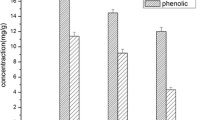Abstract
The antioxidant activity of the stem bark fromAlbizzia julibrissin was evaluated for its potential to scavenge 1,1-diphenyl-2-picrylhydrazyl (DPPH) radicals, to inhibit the generation of the hydroxyl radical (OH), total reactive oxygen species (ROS) and to scavenge authentic peroxynitrites (ONOO). The methanol extract ofA. julibrissin exhibited strong antioxidant activity in the tested model systems. Therefore, it was further fractionated using several solvents. The antioxidant activity of the individual fractions were in the order of ethyl acetate (EtOAc) <n-butanol (n-BuOH) < dichloromethane (CH2CI2) < and water (H2O). The ethyl acetate soluble fraction, which exhibited strong antioxidant activity, was further purified by repeated silicagel, Sephadex LH-20 and RP-18 gel column chromatography. Sulfuretin (1) and 3′,4′,7-trihydroxy-flavone (2) were isolated as the active principles. Compounds1 and2 exhibited good activity in all tested model systems. Compound1 exhibited five times more inhibitory activity on the total ROS than Trolox. Compound2 showed six times stronger DPPH radical scavenging activity than L-ascorbic acid. These results show the possible antioxidant activity of theA. julibrissin crude extract and its major constituents
Similar content being viewed by others
References
Blois, M. S., Antioxidant determination by the use of a stable free radical.Nature, 181, 1199–1202 (1958).
Branen, A. L., Toxicology and biochemistry of butylated hydroxy-anisole and butylated hydroxytoluene.J. Am. Oil Chem.Soc., 52, 59–63 (1975).
Chamsuksai, P., Choi, J. S., and Woo, W. S., 3′,4′,7-Trihydroxy-flavone i.Albizzia julibrissin.Arch. Pharm. Res., 4, 129–131 (1981).
Choi, J. W., Yoon, B-. J., Huh, K., Park, K-. Y., Lee, K-. T., and Park, H-. J., Anti-rheumatoidal effect of sulfuretin isolated from the heartwood ofRhus veniciflua in rats and mice.Nutraceuticals and Food, 7, 347–352 (2002).
Farag, S. F., EI-Emary, N. A., Makboul, M. A., Hasanean, H. A., and Niwa, M., Phytochemical investigation o.Wedelia prostata Hooket ARN. (HEMSL); -The ethyl acetate soluble fraction of the methanol extract.Bull. Pharm. Sci., 20, 37–46 (1997).
Jung, M. J., Kang, S. S., and Choi, J. S., A new 4-hydoxy-dodec-2E-enedioic acid from the stem bark o.Albizzia julibrissin.Arch. Pharm. Res., 26, 207–209 (2003).
Kang, S. S. and Woo, W. S., Sapogenins fromAlbizzia julibrissin.Arch. Pharm. Res., 6, 25–28 (1983).
Kim, T. J.,Korean Resources Plants. II. Seoul National University Press, Korea, pp. 194–195 (1996).
Kooy, N. W., Royall, J. A., Ischiropoulos, H., and Beckman, J. S., Peroxynitrite-mediated oxidation of dihydrorhodamine 123.Free Rad. Biol. Med., 16, 149–156 (1994).
Label, C. P. and Bondy, S. C., Sensitive and rapid quantitation of oxygen reactive species formation in rat synaptosomes.Neurochem. Int., 17, 435–441 (1990).
Lee, S. J., Son, K. H., Chang, H. W., Do, J. C., Jung, K. Y., and Kang, S. S., Antiinflammatory activity of naturally occurring flavone and flavonol glycosides.Arch. Pharm. Res., 16, 25–28 (1993).
Morel, I., Lescoat, G., Cognel, P., Sergent, O., Pasdelop, N., Brissot, P., Cillard, P., and Cillard, J., Antioxidant and iron-chelating activities of the flavonoids catechins, quercetin and diosmetin on iron-loaded rat hepatocyte cultures.Biochem. Pharmacol., 45, 13–19 (1993).
Oshima, H., Yoshie, Y., Auriol, S., and Gillbert, I., Antioxidant and pro-oxidant actions of flavonoids: Effects on DNA damage induced by nitric oxide, peroxynitrite and nitroxyl anion.Free Rad. Biol. Med., 25, 1057–1065 (1998).
Park, H-. J., Kwon, S-. H., Kim, G-. T., Lee, J-. H., Choi, J-. H., Choi, J. W., and Park, K-. Y., Physicochemical and biological characteristics of flavonoids to isolated from the heartwoods ofRhus vernicrflus. Kor.J. Pharmacogn., 31, 345–350 (2000).
Podrez, E. A., Schmitt, D., Hoff, H. F., and Hazen, S. L., Myelo-peroxidase-generated reactive nitrogen species convert LDL into an atherogenic formin vitro.J. Clin. Invest., 103, 1547–1560 (1999).
Rice-Evans, C. A., Miller, N., and Paganga, G., Structure-anti-oxidant activity relationships of flavonoids and phenolic acids.Free Rad. Biol. Med., 20, 933–956 (1996).
Sagar, S., Kallo, I. J., Kaul, N., Ganguly, N. K., and Sharma, B., Oxygen free radicals in essential hypertension.Mol. Cell Biochem., 111, 103–108 (1992).
Salah, N., Miller, N. J., Paganga, G., Tijburg, L., Bolwell, G. P., and Rice-Evans, C., Polyphenols flavanols as scavengers of aqueous phase radicals and as chain-breaking antioxidants.Arch. Biochem. Biophys., 322, 339–346 (1995).
Squadrito, G. L. and Pryor, W. A., Oxidative chemistry of nitric oxide: the roles of superoxide, peroxynitrite, and carbon dioxide.Free Rad. Biol. Med., 25, 392–403 (1998).
Westenburg, H. E., Lee, K-. J., Lee, S. K., Fong, H. H. S., and Van Breemen, R. B., Activity-guided isolation of antioxidative constituents ofCotinus coggygria.J. Nat. Prod., 63, 1696–1698 (2000).
Woo, W. S., and Kang, S. S., Isolation of a new monoterpene conjugated triterpenoid from the stem bark ofAlbizzia julibrissin.J. Nat. Prod., 47, 547–549 (1984).
Author information
Authors and Affiliations
Corresponding author
Rights and permissions
About this article
Cite this article
Jung, M.J., Chung, H.Y., Kang, S.S. et al. Antioxidant activity from the stem bark ofAlbizzia julibrissin . Arch Pharm Res 26, 458–462 (2003). https://doi.org/10.1007/BF02976862
Received:
Issue Date:
DOI: https://doi.org/10.1007/BF02976862




